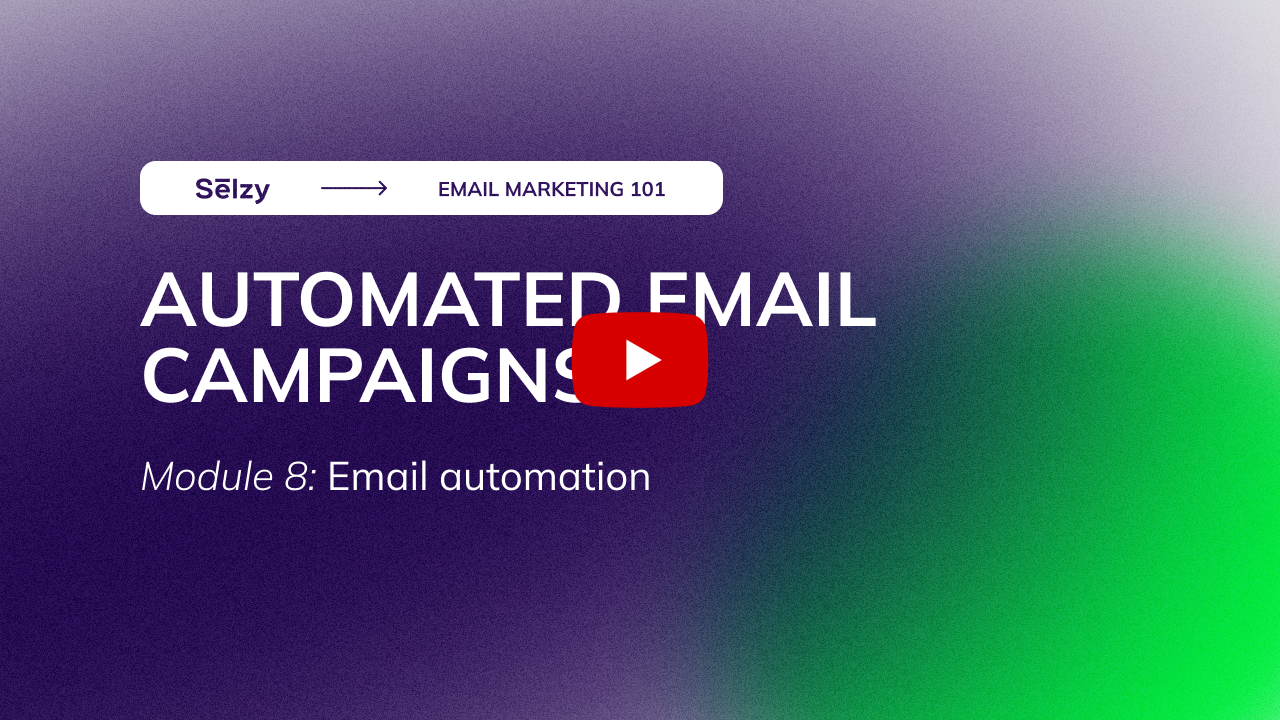Hello and welcome to Module 8. In this part of our course, we’ll talk about email automation and learn how to create automated sequences in Selzy.
Sending each email manually is a handful. But if you set up conditional automated sequences in your email marketing software, you save time. It’s also an opportunity to build a better rapport with customers — emails are “responding” to customers’ actions. The numbers confirm this — according to Omnisend, automated emails generate 29% of all email sales. Even better, 35% of consumers who clicked on an automated email end up purchasing something compared to 6.7% of one-off email campaigns.
Now let’s explore different types of automated emails.
#1: Welcome emails — an instant “hello”
Welcome emails are the first emails your customers receive after confirming the subscription or signing up on your website. The goal and the content of welcome emails depend on the industry — here are some examples:
- Teaching a new customer how to use your app
- Showing a new customer what is in store (literally!)
- Guiding a new customer through your website
- Highlighting the unique value of your product or service

This visual is only available in a video lesson
#2: Re-engagement emails
Unlike other automated campaigns we mentioned earlier, re-engagement emails are triggered by inaction. They’re sent when a customer stops using your app, visiting your website, or engaging with your emails. Re-engagement emails vary a lot in content, depending on the industry, and may include:
- A short “We miss you” message
- A “Here’s what you missed” digest
- A feedback request
- A reminder of the unique value of your product, service, or content
- A personal discount code, a gift, or a prolonged free trial
Duolingo doesn’t stop on one re-engagement email — the app sends a whole sequence as a part of their practice reminders campaign. Here’s an email you get after missing a couple of days.

This visual is only available in a video lesson
Here’s an email you get after a week of not practicing.

This visual is only available in a video lesson
And finally, Duo keeps learning without you once you skip a whole month.

This visual is only available in a video lesson
#3: Cart and browse abandonment emails
It’s a subtype of re-engagement email that is sent several days after a customer browsed items on your website or added them to cart but didn’t complete a purchase. The average cart abandonment rate in online retail is about 70%, according to Baymard Institute. That’s why sending such emails can drastically increase your sales.

This visual is only available in a video lesson
#4: Holiday and milestone emails
Holiday email campaigns like Christmas are pretty simple. You set them up manually once a year, and these emails will be delivered to everyone in your list at the same time. But what about birthdays? Or anniversaries like “You spent a year with our business”?
If you have 5 customers, setting up each email manually is a handful but not impossible. However, as you’re scaling up, it will be a problem. Imagine manually scheduling 5000 birthday emails — you’ll spend weeks doing this monkey job and make embarrassing mistakes. The solution is automation.

This visual is only available in a video lesson
These types of triggered campaigns are entry-level automation. But even implementing a welcome sequence will boost your email marketing game up to 11. We’ll show you how to do it in Selzy in our next lesson. Now, let’s talk about a more complex type of automated emails. Ladies and gentlemen, meet the almighty drip campaigns.
#5: Drip campaigns
How do you make a friend? You meet someone, have a conversation, exchange numbers, text and send memes, go to events together, invite them over, and after some time and shared experiences you become vulnerable with each other. You can’t jump to discussing your emotional needs with a person you’ve known for a minute, right?
The same goes for customers — they go through a journey similar to making a friend. This journey is called a sales funnel. It consists of five stages:

This visual is only available in a video lesson
The first stage is Awareness, when a customer only learns about your company. It’s followed by Interest, when a customer becomes curious about your UVP. The next stage is Desire, the name explains itself — a customer wants to buy something from you. The purchase itself is Action. And, depending on many things, your customer might move to the final stage — Loyalty.
This explanation may come off as a bit confusing though. Let’s get more specific using an example of a dance school.
A customer discovers the school on social media — this is the Awareness stage. Then, they learn about different dance styles from the school’s blog — it’s Interest. They get interested enough to book a free trial class — it’s Desire. After that, the customer pays a month ahead and starts their learning journey — it’s Action. Finally, they get invested enough to pay a year ahead and take part in a referral program — it’s Loyalty.
These steps require a sales manager and direct communication with every new customer. But the entire journey we described can be automated with a sequence of triggered and scheduled emails. Let’s rewrite the example above:
A customer discovers the school and subscribes to the email list. Then, they receive a welcome sequence about the school, their approach to teaching, success stories, and social proof. After reading all that, they book a free class via email. Three days after a free class, they receives an email that suggests enrolling in a group. A month later, they get an email that suggests applying for a year-long program.

This visual is only available in a video lesson
Basically, all these types of automated campaigns we discussed earlier can be linked to the sales funnel and work together to nurture your customer. What if a customer drops off at one of these stages? Scheduled re-engagement emails will help them get back on track.
The takeaway is, automated emails save you time and money on hiring junior sales managers, and allow you to think strategically when it comes to email marketing. Don’t jump to thinking out the year-long plan yet though — let’s start small. In the next lesson, we’ll put our theory to practice and set up a welcome sequence in Selzy.
This is a transcript of lesson 20 of Email Marketing 101 Course by Selzy.
